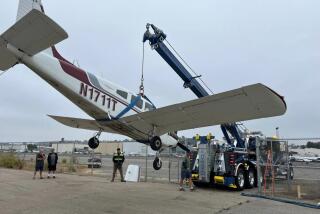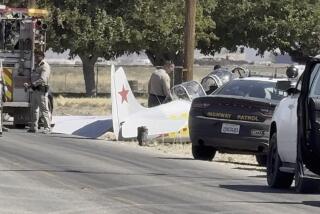Skydiver Plane Crash Blamed on Pilot Error
Pilot error--a mistaken reaction after contaminated fuel killed one engine--was to blame for the crash of a skydivers’ plane near Perris last year that killed 16 people, federal officials said Monday.
National Transportation Safety Board investigators said that pilot Rowland Guilford, 44, who died in the crash, inadvertently “feathered” the propeller of the engine that was still working, rotating the propeller’s blades so that it no longer could pull the plane through the air. This left the plane without propulsion, and it crashed on takeoff.
Guilford, 44, had meant to feather the disabled engine’s propeller, which would have kept it from pinwheeling and slowing the plane.
The safety board had noted earlier that an automatic feathering system--equipment that might have precluded Guilford’s mistake--had been removed from the plane, a De Havilland Twin Otter DHC 6-200, which was carrying 22 people.
In addition to pilot error, the board’s final report on the April 22, 1992, crash on takeoff at Perris Valley Airport blamed the plane’s operator--Perris Aviation Services Inc.--for failing “to assure that the pilot was provided with adequate training in the airplane.”
The board said several factors contributed to the crash: fuel contaminated with dirty water, the overloading of the aircraft with skydivers and equipment that was too far forward in the plane, and the aviation service’s lack of adequate fuel quality-control procedures.
The failure of the engine, in itself, was not blamed for the crash because of a presumption that the aircraft--if properly maintained, loaded and piloted--could have taken off successfully even if only one of its two engines had been fully functioning.
Officers of Perris Valley Aviation Services Inc. and the Perris Valley Sky Diving School, which leased the plane, were not immediately available for comment on the safety board’s findings.
Perris Valley Airport, about 70 miles east of Los Angeles, is one of the busiest parachuting centers in the world. Among those aboard the plane that day were jump instructors, video camera operators and three four-member teams training for national skydiving competition. Only the cockpit crew wore seat belts.
Examination of the wreckage has shown that the load the plane was carrying was too far forward. This imbalance would have made the aircraft relatively unstable, aviation sources said.
Had the aircraft been equipped with an auto-feathering device--which would have made the plane easier to control in the event of engine failure--the allowable load limit would have been 11,579 pounds, and the gross weight of 11,556 pounds would have been acceptable.
But because the feathering device had been removed by the owner, the allowable weight was lowered to 9,900 pounds. The plane was 1,600 pounds over the maximum allowable takeoff weight under the existing flight conditions when it taxied onto the runway for takeoff on April 22.
Bennie A. Conatser, owner of the plane, said the auto-feathering equipment had been disconnected when he purchased the plane in 1989, and it was later removed. He said owners frequently disconnect the devices because they are unreliable.
Survivors and witnesses said the plane, powered by two 550-horsepower turboprop engines, accelerated down the runway and lifted about 50 feet into the air. Then, without warning, the right engine failed and the plane veered to the right.
The safety board said the right engine failed because the fuel that fed it was contaminated with dirty water. Investigators said equipment used by an outside supplier had not been properly purged of water before it was used to transfer fuel from an airport reservoir to a truck used to refuel planes. The board said Perris Valley Aviation failed to take adequate steps to assure that the aircraft fuel was not contaminated.
Examination of the wreckage showed that when the engine failed, Guilford reacted quickly but incorrectly, the investigators said. They said that instead of feathering the disabled right engine to reduce the drag caused by its pinwheeling propeller, Guilford feathered the functioning left engine. With neither engine providing forward propulsion, the plane slammed into the ground.
During the investigation, investigators determined that Perris Valley Aviation had failed to make sure that Guilford had been trained adequately, the board said.
More to Read
Sign up for Essential California
The most important California stories and recommendations in your inbox every morning.
You may occasionally receive promotional content from the Los Angeles Times.









